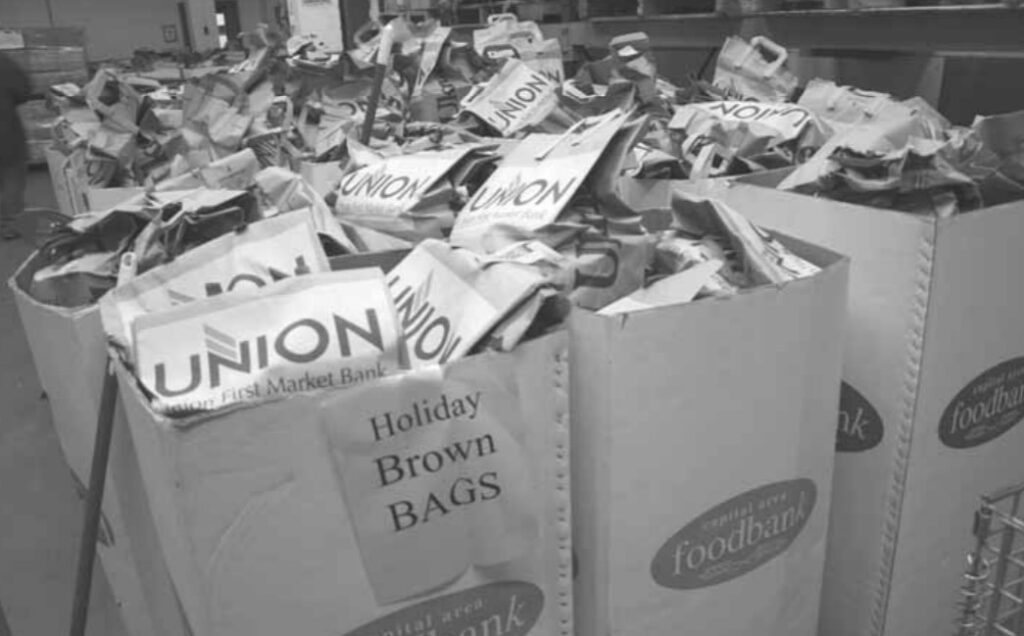The need for donated food has grown substantially during the economic downturn
The holiday season is upon us and dinner is on our minds. When D.C. residents gather together to enjoy a feast and share what they are thankful for, many will be thankful for the Capital Area Food Bank, who will distribute about 15,000 turkeys this year, most received from Jaindl Farms in Pennsylvania.
“There’s a spike in donations during the holiday season,” said Shamia Holloway, communications manager at the Capital Area Food Bank. “People are thinking about hunger.”
But in these tough economic times, there has also been a spike in need. The demand for food has risen by 25 percent in the past four years, Holloway said. Charities and helping agencies all over the region and the nation are seeing more people in need of food. And there are new faces in those lines.
“The face of hunger has changed,” said Holloway. The Capital Area Food Bank has always helped poor and working-poor people. Now former members of the middle class have joined the ranks of the needy. These are people who have never been to a food bank before, said Holloway. “We’ve even had former donors coming back to ask for food,” she said.

warehouse has several sections, including a bulk food section, serving 478,000 people each year. Photo by Kim Kroll.
This year, the Capital Area Food Bank has distributed 30 million pounds of food – up from 27 million pounds last year, said Holloway. More than 10 million pounds has been fresh produce.
The Capital Area Food Bank serves more than 478,000 people each year, nearly half of them children. But the food bank doesn’t get all that food into the hands of hungry people by itself. It is the grub-hub in D.C. for 700 partner agencies such as food pantries, soup kitchens, homeless shelters, church outreach programs, afterschool programs, and many more. Without the food bank, many of these organizations wouldn’t be able to feed their clients.
“We purchase more than half of our food from the food bank,” said Greg Bloom, a spokesman for Bread for the City, a nonprofit that offers free food, clothing distribution, primary medical care, legal counseling and social services to more than 10,000 needy residents a month. “During the holidays, we run a special program called Holiday Helpings, in which we provide each client with a complete holiday meal – a turkey and all the trimmings. Most of this food we purchase from the food bank, including the turkeys, which I’m told are the leanest and best birds available. It costs us just $29 to provide Holiday Helpings to a family of four.”
Like every other organization, Bread for the City has seen need increase steeply in recent years. Partner agencies don’t want to turn anyone away, said Holloway. So many have been carefully rationing out their food to make it stretch.
The food bank is not federally funded; it receives most of its food through donations. Donations come from places such as local grocers, local farms, and food drives. Local supermarkets, such as Safeway and Giant, the food bank’s biggest local grocery partners, donate reclaimed items, products where the packaging may be damaged or dented, but the quality of the food product is unaffected.
Local farms donate or allow the food bank to purchase fresh produce. Food drives sponsored by organizations such as churches, schools, and federal government groups bring in a large amount of food as well.
The “Feds Feed Families” food drive that ran from June to September this year, for example, brought in over 3,000 pounds of food with the help of government employees.
The food bank is very concerned with the health and safety of its food. It does not accept expired or perishable food donations from the community. Perishable foods such as meats and dairy products, which are purchased by the food bank or obtained by donating partners are brought to the food bank directly, in accordance with food safety guidelines.
The food bank also purchases bulk items from the government through The Emergency Food Assistance Program, where it can obtain these items more cheaply for partner agencies.
This means partner agencies have a wealth of food to choose from; some agencies send representatives to the food bank to “shop” for bulk food. The representative uses a membership card to choose items off of the agency’s shopping list. A food bank employee then takes the list, retrieves the items and brings them to the loading dock. The bulk food section looks like a warehouse. Stacks upon stacks of cases of food, filled with cans, jars, boxes, even bananas, loom above workers zooming around on forklift machines and pushing flatbeds around to the organized sections to retrieve items.
A second way agencies collect their food from the food bank is more like the traditional trip to the grocery store, but instead of a small shopping cart, agency representatives push around flatbeds stacked with boxes full of food items. Agencies can handshop in the shopping section of the food bank for smaller items such as meats, dairy products, fresh produce, loaves of bread, boxes of pasta, tuna fish, and more. The agencies can even shop for hygiene items in this section, such as diapers, feminine products, tissues, shaving products, deodorants and the like.

There are limits as to how many of each of these kinds of items can be chosen per agency, and they are set up on shelves or in freezers just as they would be in a normal supermarket, but you can see the bulk food towering behind. When you walk into the food bank storage area, the hand-shopping is located right at the entrance within the huge warehouse, right where the loading docks are.
When the partner agencies come in to shop, they don’t buy the food. The payment made is a maintenance fee, which is 13 cents per pound of food that they take away. That takes care of the utilities to run the food bank facility itself, as well as the transport of food.
The food bank’s reach even stretches beyond the walls of its facility. They host a program to teach agencies how to cook with food bank food, especially bulk items. Many of the bulk items are staples that can be stretched across many platforms such as tomato sauce and beans. Jodie Balis, coordinator of “Cooking for Health with Capital Area Food Bank,” helps agencies to feel confident that they can serve as many people as possible with the food they take away.
Cynthia Summers from Builders Inc. says the amount of food that she decides to take depends on the number of people that come through the agency and health standards.
“Nutritional value of what we’re giving matters since we only serve Thursdays of every month from 10 a.m. to 2 p.m., and each family can only come once a month,” said Summers.
One of the biggest food drives of the year, “Stuff a Truck,” is held during the holiday season, this year on Dec. 10. At four Giant Food branches, FOX5 and CBS Radio will come and host live entertainment all day for the community, while community members come to the trucks to make donations. And there is even a special program to help senior citizens throughout the holiday season. Senior citizens receive a holiday bag through a special program called “Bringing in the Birds with Bucks,” as part of the larger Brown Bag program.
Senior citizens can sign up for a monthly brown bag full of supplemental food through a partner agency. Many times senior citizens who are on a fixed income have to choose between buying medicine and buying nutritious food, so the brown bags help to keep them healthy, said Holloway.
The Brown Bag program fills a serious need, agreed Jenna Jones, Volunteer Coordinator of senior services at So Others Might Eat.
“We have 57 participants in the Brown Bag program, and that number jumped by 10 people in one year. I call that our growing pains,” she said. Getting the food to the seniors stretches Jones’ resources, but the effort is worthwhile. “That is a whole lot more food to carry in and unload. It’s also a challenge because I need more volunteers to deliver food into the community.”
Senior citizens will receive a holiday bag through a special program called “Bringing in the Birds with Bucks,” as part of the larger Brown Bag program.
“We partnered with the food bank through the Brown Bag program and received 57 seven-pound turkey breasts for each participant. Then we partnered with Harris Teeter and with a corporate donation got more than 50 turkey breasts at a good sale price, and had enough leftover money to buy 92 pies,” said Jones. “Our real blessing is that we got to provide everyone with a turkey breast this year.”
The additional turkey breasts went to senior citizens who do not participate in the Brown Bag program because they either do not qualify or did not fill out the paperwork, said Jones.
Donations are at their peak during the holiday season but hunger is a year-round concern.
“During the summer people aren’t thinking about giving,” said Holloway. This is a problem because students aren’t in school, and parents are struggling to feed kids when they didn’t have to worry about it before. Fifty-six percent of the households served by the food bank have at least one working adult, according to Hunger in America 2010, a Mathematica Policy Research study. This shows the need in this economic environment for financial assistance when it comes to hunger.
The food bank’s Kid’s Café section was created to help provide children who take part in free lunch programs at school with nutritious food at times when they’re not in school. Some of the Kid’s Café locations are partner agencies, but also community centers, churches, or even apartment complexes; anywhere that has afterschool programs for kids.
“We don’t just distribute food, we distribute healthy food. They don’t have access to healthy food. The quickest store is a corner store,” said Holloway.
The Kid’s Café program tries to provide the children access to healthy food, while presenting it to them in a way where they’re learning about what they’re eating. Having learned about the food, when they actually like it, the children will go home and say, “Look mom, I like this,” said Holloway.







